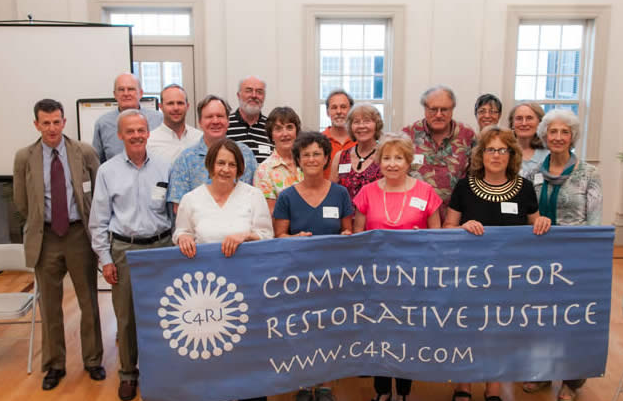Photo: Restorative Justice project in Concord.
Your car has been vandalized. Someone broke into your house at night. Shoplifters attacked the business you own. You were assaulted by “a friend.”
You are a victim of a crime and you want justice.
In the past forty years, the expected action from law enforcement and the courts were to take the perpetrator, convict them with the harshest sentence and lock them up.
And while that might be satisfactory, it, for the most part, doesn’t restore a sense of safety to or provide a lasting resolution to the victim.
According to Erin Freeborn and Belmont Police’s Asst. Chief James MacIsaac, there is a better way. Rather than throwing away the keys, bring the victim and culprit together. “Hold the offender accountable so healing can begin and everything is put right,” said Freeborn, executive director of C4RJ, a non-profit community-police partnership that offers restorative justice to those affected by crime.
And Belmont PD announced at the Belmont Board of Selectmen’s meeting on Monday, Dec. 17, it has joined 24 other Massachusetts police departments (including Arlington, Cambridge, and Lexington) and the Middlesex and Suffolk country district of attorneys partnering with C4RJ.
The Concord-based organization in operation since 2000 is driven by a group of trained volunteers recognizes crimes is a violation of people and relationships, not just a violation of the law. The focus of the organization is to assist victims and offenders of a crime through a healing approach outside the court system.
C4RJ builds strong, respectful communities by responding to a crime in ways other than tough sentencing. C4RJ listens to victims, holds offenders accountable, and restores trust in communities.
Through C4RJ’s process, victims of a crime respond to an incident by directly addressing the person who committed the crime. In turn, offenders are given the chance to rectify their actions and avoid a potential criminal conviction on their record.
“Where once a fistfight after school was seen past part of growing up, now that could be considered a felony assault with real harsh consequences,” said Freeborn. “We want to reduce the number of people being incarcerated and [restorative justice programs] are one way to do that.”
Partner police departments recommend cases to C4RJ. If the victim and the offender agree to the process, the matter is given to C4RJ, which sets up a meeting between both parties, putting the decision making into the hands of those directly affected.
Together, under the guidance of the board of directors and law enforcement officials, the victim, the offender, and their loved ones and supporters, along with community members discuss the crime and find a way to move forward. The process is as follows:
- Victims of crime address the person or people who have harmed them, to ask questions in a safe environment, and to share ideas on ways that the offender can repair the harm.
- Offenders better understand the impact of their actions, are held accountable and encouraged to make amends to those they have harmed.
- The community offers support for the process, addressing matters of public safety and strengthening connections with the police department.
At the end of the meeting, the offender pledges to change his or her actions, which are often accompanied by completing a number of service hours for an appropriate organization. In 60 to 90 days, all parties meet again to check in and reassess the situation.
This approach appears to work: the recidivism rate using the C4RJ approach is 16 percent as compared to 31 percent reincarceration rate (within three years) in Massachusetts, according to a 2018 National Reentry Resource Center study.
“By giving victims and offenders of a crime the opportunity to express themselves in a safe environment, we can have a dialogue that yields positive results for both sides,” said Freeborn.
C4RJ will be holding its next volunteer training on Feb. 8 (6 p.m. to 9 p.m.) and Feb. 9 (9 a.m. to 4 p.m.). The first step is a volunteer application found at https://bit.ly/2ya8z5K.








Leave a Review or Comment